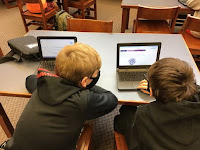The last several weeks of Literacy Studies classes have been filled with lessons and activities related to information literacy and evaluating sources. Much of the work was based on the book Fact vs. Fiction: Teaching Critical Thinking Skills in the Age of Fake News by Jennifer LaGarde and Darren Hudgins.
To begin our work, students picked apart the pieces of the story of Frida, a young girl apparently trapped in a collapsed elementary school in Mexico City after an earthquake. The story, as retold in Fact vs. Fiction, recounted the hours after the earthquake when rescuers claimed to have seen and heard from the trapped girl. World-wide coverage of the story ensued, and #Frida trended on Twitter. In the end, there was no trapped girl. The story illustrates how a story can gain traction--even a story that isn't true.
Student participated in a sorting activity that included elements from the story. Using categories from Fact vs. Fiction, students chose where to place story elements, and then defended their choices during discussion. Categories included: famous names and places, a few facts, legitimate news information, eye witnesses, and emotional investment or connection.
Next, students examined examples of "fake news," which we learn is likely one of four kinds of stories:
1) propaganda
2) disinformation
3) conspiracy theory
4) click bait
After discussing what we already knew, we looked at specific examples of each, then participated in a Four Corners activity when looking at different examples. Once students made their choices, they explained why they made the choices they did.
Once students had specific vocabulary for "fake news," it was time to evaluate online sources, as that's where students--and indeed, many of us--primarily get our information. Together we looked at a checklist of things to do and look for when examining websites.
We applied the checklist to a site together--
The Jackalope Conspiracy--and gathered "the evidence" to make a decision about the site: Is it propaganda, disinformation, conspiracy theory, or click bait?
Students also worked independently (or with a partner) to evaluate an assigned website from the list above. Not every site on the list was disinformation; some were accurate websites. Students worked through their checklists and read laterally to try to confirm the information on the sites they were evaluating.
Students' final activity was to visit
snopes.com to see how it can be used as another tool in website and information evaluation and fact checking.
Using tools at
snopes.com, students search for information provided to them, and they also had time to search for an item of their own interest to determine the accuracy of the story and information.
Finally, students completed a quick survey to provide some feedback regarding their understanding of information literacy and source evaluation before we began our work compared to their knowledge of these things after our activities and reading. The good news? After participating in lessons and activities, students reported a nearly 20% increase in their confidence related to evaluation skills when looking at information online.











































